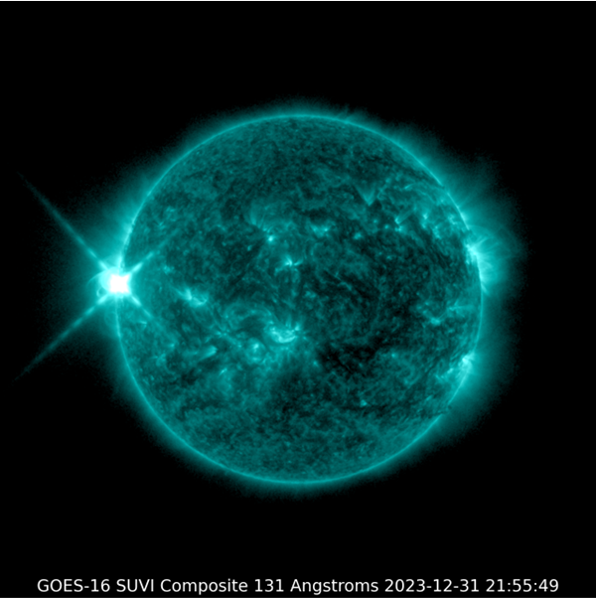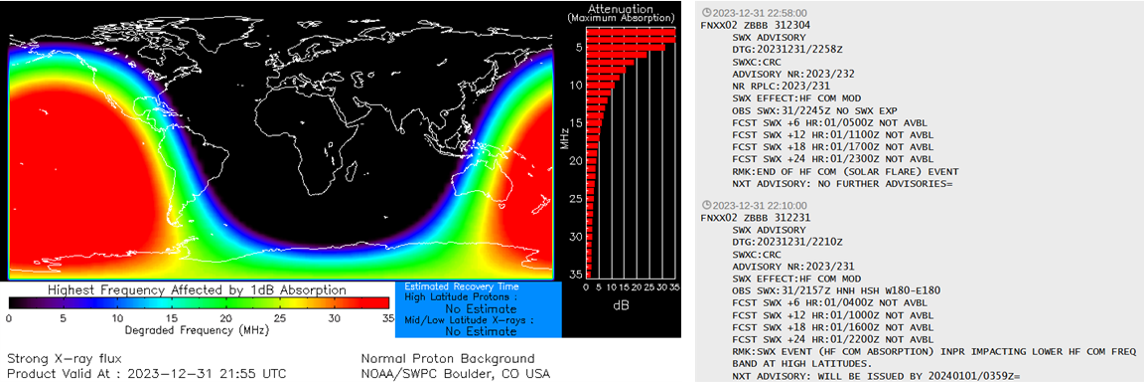The year 2023 ended with a bang! On New Year's Eve, an X5.0 flare peaked at 21:55UTC. The GOES/SUVI 131 image underneath shows the flare in extreme ultraviolet at its maximum.

The source of this powerful flare is active region NOAA 3536, which just today started to rotate over the eastern solar limb. Helioseismological images (Stanford) allowed space weather experts to track it during its farside transit over the last 2 weeks. The map underneath (early on 31 December) shows the solar surface between latitudes -60° and +60°. The grey portion is a magnetogram as seen from the Earth with yellow-red and blue-green spots representing the magnetic polarities of active regions. The orange portion of the map shows the farside of the Sun, with brown and black indicating the location of active regions. There's clearly a huge region rotating from the orange portion to the grey portion of the map, meaning that what we see now is just the leading portion of the sunspot group as it rounds the eastern solar limb. The location of the group coincides with that of NOAA 3514, a sunspot group responsible for the previous record of strongest flares in SC25, producing an X2.8 flare on 14 December (see this newsitem at https://www.sidc.be/article/x28-flare ). It is unclear if this is the further development of old NOAA 3514, or a new region that has developed near the same location. H-alpha images indicate that the X5 flare was produced by the leading portion of NOAA 3536, i.e. the main leading sunspot.

Solar demon (SIDC) has detected a coronal wave that reached all the way to the central meridian (image compilation underneath). Though there are no coronagraphic imagery yet, this suggests that an associated coronal mass ejection might have an earth-directed component that may deliver a glancing blow to the earth environment. Further updates in the SIDC space weather bulletins as coronagraphic images become available (https://www.sidc.be/index.php ). The greater than 10 MeV proton flux was already somewhat enhanced prior to the event, and showed a further enhancement after 23UTC. In view of the eastern location of the flare source chances are small (but not zero) that a proton event slowly develops in association with this X5 flare.

The USAF radio telescope network (NOAA) reports quite important radio disturbances in particular at frequencies of a few 100 MHz and of several GHz. The 22UTC value of the 10.7cm radio flux as measured in Penticton (BC, Canada) was affected with a value well near 240 solar flux units (sfu). The undisturbed value is currently around 140 sfu. The 20UTC radio flux value was not impacted by today's X-class event. The map underneath (D-RAP ; left) shows that the soft-ray and EUV emission from this flaring event may have resulted in a radio black-out affecting HF radio communications mainly over the Pacific, New-Zealand, and East-Australia. An advisory for civil aviation has been issued (PECASUS , China-Russia Consortium ; right).






